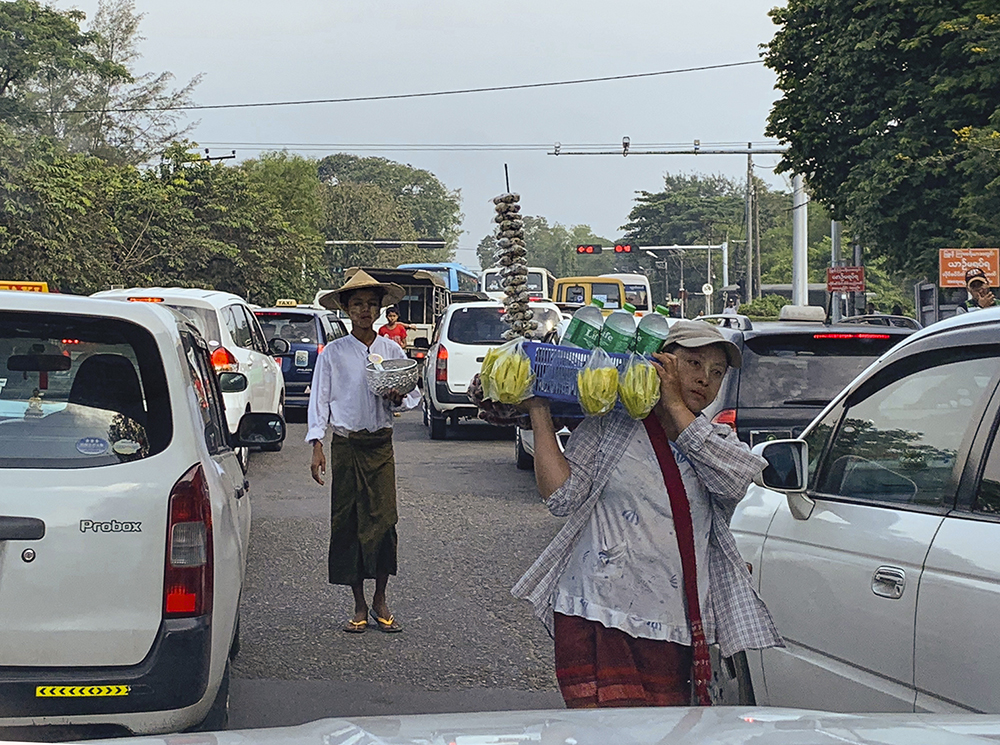Part 1: Driving in Myanmar
Driving in Yangon? You gotta be kidding
A flooded landscape rushed by as the plane approached Yangon International Airport. The beginning of the rainy season was not the best time to be setting off on a self-driving research assignment in Myanmar.
My job was to gather and compile route data into a PDF free to download at no obligation from a car-rental company website. I had done this for a company in “Amazing Thailand” in the late 1990s, where renting cars became popular with tourists. Why, then, wouldn’t visitors also want to drive themselves into the magic and mystery of Myanmar?
“It was the same in Thailand 20 years ago,” the boss said when we met in the company office in a suburb of Yangon at the start of the project in May 2017. He assigned a young fleet manager to go along with me for the first two days.
My sole previous trip to Myanmar had been in 1996, when I had come with a friend to photograph Kachin folk for a book. A young Kachin had driven us around Myitkina for 12 days in a vintage jeep in the heat of April. Burned into memory was the magic of the first cold drink when ice became available at the end of the day. The mystery was why a state capital only had electricity for a few hours from mid-afternoon.
The misfortunes that had befallen Myanmar had long been widely reported in Thailand. Good reads like Thant Myint-U’s “River of Lost Footsteps” and Pascal Khoo Thwe’s “Land of Green Ghosts” provided background. But the fact that restrictions preventing foreigners from driving had been quietly lifted without fanfare by 2016 was proof that Myanmar was changing.
A company driver took me to a comfortable, business-style hotel off Thamine Station Road and left me there with a new 4WD Ford Ranger. The hotel was quiet, but the neighborhood was drab. After dark, small stores sent shafts of light onto unlit sidewalks. Buildings were mostly shuttered.
Staying in a hotel room seemed a waste of a first night in a new city, but I was not ready to drive. I took a taxi downtown to the Bagan Book House for 6,000 kyats (US$4.20). He took a complicated route on side streets to avoid traffic jammed up on main roads. Parking downtown appeared horrendous. Driving in Yangon looked no fun.

I bought a copy of Maw-Naing and Han’s “A Burmese Heart” and then walked around before having stir-fried noodles in a local diner. Later, I sat at a curbside tea stall and chatted with a student sitting in a low chair near mine.
Five taxi drivers turned down my fare before one agreed to take me back to the hotel. He looked at Google Maps on my phone before calling the hotel to get directions. The ride back cost 4,000 kyats.
Letting someone else drive in Yangon feels good, even when you pay over the rate for a taxi or suffer Yangon’s clammy heat should its driver keep the windows down, provided you keep moving. In Yangon, the latter is nigh impossible.
A shaky start
Sitting behind the wheel of the Ranger the next morning, I felt nervous. The executive assigned to go with me had been introduced to me as Tom. He told me where to go, allowing me to take the wheel and concentrate on driving. The steering wheel was where it should be in Myanmar; on the left side of the vehicle.
All vehicles in Thailand, where driving is on the left, have steering wheels on the right. The strange thing is, so do more than 80 percent of vehicles in Myanmar despite the changeover to driving on the right side of the road in 1972.
Compared to Thai drivers, Yangon’s drivers appeared to follow lane discipline and stop when traffic lights turn green to amber — braking on amber in Thailand might get you rear-ended.
I approached intersections with caution. Other drivers also seemed cautious and let us through. After Thailand, this was refreshingly different; or were local drivers just being courteous to a foreigner?
Was such caution due to steering wheels being on the wrong side, perversely resulting in less accidents? Was this change from driving on the left side of the road to the right in 1972 truly made on the advice of General Ne Win’s soothsayer as a rumor suggested? The complications that had ensued from this perplexing decision were plain to see.
After 45 or so minutes of driving through Yangon’s northern outskirts, I didn’t need any more driving practice. Tom took over the wheel, letting me go back to Google Maps and street views.
I had a job to do but wasn’t sure how it was going to work out. I spoke no Burmese and depended on an app I had barely used. For the first day, rather than the easy Yangon-Mandalay Highway to Bago, I planned to follow a rural side road to get off the beaten track. I’d come back the easy way on the return.
Tom wanted to be in Myawaddy, Karen State to do some business there on the second day, so with a journey of around 450 kilometers to do, we should have made it fairly easily.
Driving in Myanmar—the essentials
- You must have an International Driver’s Permit or an ASEAN driver’s license to drive in Myanmar. Pre-book your car.
- Buy a Myanmar SIM card on arrival—your phone will be essential for navigation and finding places. Bring a device holder for the windscreen.
Oliver Hargreave created “WorldClass Drives in Myanmar” for Yomacarshare.com. Opinions expressed in this article are not those of Yomacarshare.

















